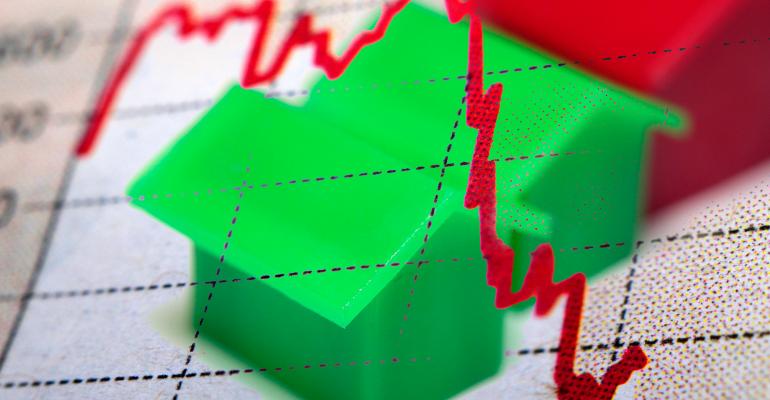(Bloomberg)—Ivy Zelman, the housing analyst famous on Wall Street for calling the top of the market in 2005, less than two years before the collapse, sees warning signs once again.
After a historic run-up in values during the pandemic, housing in the U.S. is at -- or near -- the peak, she says. She’s cautioning clients that overheated areas with heavy concentrations of investors, including Phoenix, are likely to face “corrections.” A modest rise in 30-year mortgage rates, even to 4%, would bring demand to a halt, according to Zelman.
Cracks are already appearing: The pace of price growth nationwide has started to slow, and in Covid boomtowns such as Boise, Idaho, and Salt Lake City, bidding wars are suddenly giving way to discounts.
Zelman, 55, isn’t forecasting a nationwide crash on the scale of the last bubble, which was magnified by risky subprime mortgage lending. But the signs of trouble look familiar, she says: Investors are distorting the market by driving up prices beyond the reach of primary buyers, and builders with growing construction pipelines are bidding up land values.
The risk is that investors -- from iBuyers to private equity firms acquiring and building single-family homes for rent -- get spooked and start selling, overloading the market with supply. By the time builders finish homes they’ve now just started, demand may no longer be there, she says.
“If I’m a homebuyer right now,” Zelman says, “I want to wait because I think we’ve gotten to a level that’s not sustainable.”
Zelman, a former Credit Suisse Group AG analyst who co-founded her firm, Zelman & Associates, in 2007, talked to Bloomberg about her views. Her responses have been edited and condensed.
Is this the first time you’ve called the top of the housing market since the last crash?
It definitely is the first time that I’ve been concerned about the market being at peak levels, or near peak levels, since the last downturn, absolutely. And our concerns are obviously not very much the party line. We are the contrarians. Our views are grounded in fundamental research and understanding and appreciating the risk that right now I call “yellow flags.” So it may be that our concerns don’t come to fruition this year or possibly even in ’22, but we definitely see a storm brewing.
Investors, from iBuyers to private equity firms and sovereign wealth funds, are chasing housing in all forms. Won’t that just continue to prop up values?
It’s really a function of when does pricing hit a wall and when do you start to see pushback, whether it’s affordability or just buyer fatigue. I’m concerned that the market is definitely artificially inflated by investors. Prices won’t be sustainable if the returns start to flatten out or even come under pressure.
We’re faced with the worst housing shortage in history. How could that possibly change?
We don’t believe we’re in a shortage, so our view is different than the market’s perception. We’ve been more concerned about the level of growth in household formations in the U.S. Actually this past decade, it grew at the slowest pace on record.
The U.S. is seeing more consolidation in terms of households. We’re seeing more multigenerational living. I think what we are concerned about is that the normalized level of demand is being clouded, which is creating this perception that we don’t have enough inventory because of all the second homes that people now own, as well as investors, just driving up pricing.
If you’ve got iBuyers and you’ve got fix-and-flip buyers, and you’ve got private investors trying to diversify their position away from just owning equities, you’re going to have a lot more difficulty delineating true primary demand versus what I call just non-primary demand.
Would a jump in rates do more than depress affordability? Would it dissuade homeowners with low rates from trading up?
The terrible Fed policy of continuing to purchase mortgage-backed securities at $40 billion a month has kept rates at artificially low levels. The backlash of that is it’s going to impact mobility because when you look at the number of homeowners that are locked in, not at 4%, but below 4%, we’re talking almost 70% of mortgage holders. Right now, the benefit of the arbitrage is still there. If you can buy a home and get a rate lower than where you were locked in at, and you have a higher home price that you have to digest, that’s offset by the lower rate. If you have higher home prices plus higher rates, it just disincentivizes mobility.
Which homebuilder markets are you most concerned about?
Where all of the iBuyers are, where all the build-for-rent guys are, where all the for-sale guys are building. Those markets are the trifecta that are much more at risk. Phoenix, No. 1. Austin, Dallas, Houston and, to a lesser extent, Atlanta, the Carolinas.
Are we heading for a crash?
There are going to be corrections. And I think there are going to be corrections that are more pronounced if rates go higher. I certainly would be concerned if I was buying a home today in, let’s say, the Phoenix tertiary market in a higher-rate environment.
© 2021 Bloomberg L.P.





